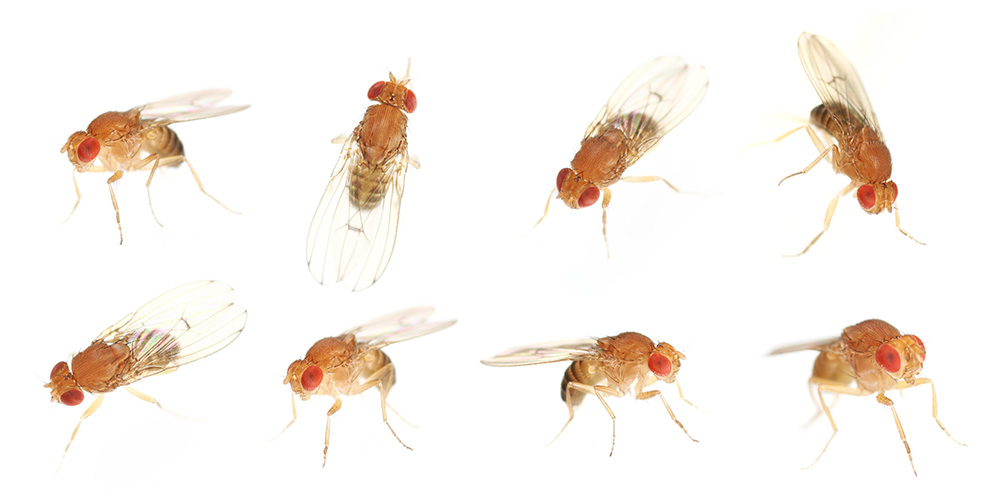Cardiolipin helps fruit flies take flight
Researchers at New York University have shown that cardiolipin, a phospholipid component of the inner mitochondrial membrane in fruit flies, exists for more than 30 days and may allow these flies to sustain wing-beat frequencies of more than 100 beats per second. In addition, they found that cardiolipin lengthens the lifetimes of fruit fly mitochondrial respiratory protein complexes. Their work was published recently in the Journal of Biological Chemistry.
Cardiolipin stabilizes mitochondrial electron transport complexes by interacting with oxidative phosphorylation, or OXPHOS, proteins, which are critical for cellular energy generation. OXPHOS is the primary mechanism that fruit fly muscles use to generate adenosine triphosphate, a cell’s energy currency.

Previous studies have shown that cardiolipin interacts with OXPHOS proteins via noncovalent interactions and that the mitochondria require this connection to work at their best. Among mitochondrial proteins, OXPHOS proteins have exceptionally long lifetimes. Most phospholipids boast a half-life of a few days. However, Mindong Ren, a research associate professor of anaesthesiology and lead author on the study, and his team showed that cardiolipin’s half-life is more than three times as long.
Ren compared proteins with cardiolipins: “Like long-lived proteins, cardiolipin can also be referred to as a long-lived lipid.”
This prompted researchers at NYU to wonder if the presence of cardiolipin impacts the longevity of OXPHOS proteins.
The team fed fruit flies, or Drosophila melanogaster, stable isotopes to measure the half-life of proteins and lipids. After feeding, these isotopes are incorporated into the flies’ existing muscle and other tissues.
“The fact that mature flies do not experience a change in their body mass makes Drosophila an excellent model organism for this experiment,” Ren said.
Since adult flies do not gain weight or grow new flight muscles, the heavy isotopes in their bodies can only be broken down by protein and lipid recycling inside their cells.
Because not all mitochondrial proteins are long-lived, Ren and his team decided to focus their work on a fruit fly tissue with minimal regeneration: the postmitotic flying muscle.
When the researchers ablated cardiolipin, the half-lives of respiratory protein complexes in the Drosophila flight muscle decreased by almost half.
These results indicate that respiratory proteins and cardiolipins live for a very long time, which is consistent with the notion that OXPHOS-containing domains in mitochondrial crista membranes are quite stable.
Ren said tightly packed cristae may explain cardiolipin and other proteins’ longevity. Crowding causes strong lipid–protein and protein–protein interactions but slows diffusion and molecular motion. Limited exposure to proteases and lipases, caused by strong interaction and slow diffusion, could increase the lifetimes of lipids and proteins.
Michael Schlame, a professor of anaesthesiology at NYU and supervising author of the study, compared cardiolipin and OXPHOS proteins to collaborators.
“We proved that cardiolipin and OXPHOS complexes last a long time and showed that they rely on each other,” Schlame said.
Ren said he was amazed at how much energy fruit flies can generate using complexes packed into small spaces.
Ren and Schlame agree that fruit flies could be useful models for researching cardiolipins and their functions in human diseases. Alterations in cardiolipin metabolism are associated with a plethora of disorders including ischemia or reperfusion injury, heart failure, cardiomyopathy and cancer.
Enjoy reading ASBMB Today?
Become a member to receive the print edition four times a year and the digital edition monthly.
Learn moreGet the latest from ASBMB Today
Enter your email address, and we’ll send you a weekly email with recent articles, interviews and more.
Latest in Science
Science highlights or most popular articles

The science of staying strong
Muscles power every movement, but they also tell the story of aging itself. Scientists are uncovering how strength fades, why some species resist it and what lifestyle and molecular clues could help preserve muscle health for life.

Bacteriophage protein could make queso fresco safer
Researchers characterized the structure and function of PlyP100, a bacteriophage protein that shows promise as a food-safe antimicrobial for preventing Listeria monocytogenes growth in fresh cheeses.

Building the blueprint to block HIV
Wesley Sundquist will present his work on the HIV capsid and revolutionary drug, Lenacapavir, at the ASBMB Annual Meeting, March 7–10, in Maryland.

Gut microbes hijack cancer pathway in high-fat diets
Researchers at the Feinstein Institutes for Medical Research found that a high-fat diet increases ammonia-producing bacteria in the gut microbiome of mice, which in turn disrupts TGF-β signaling and promotes colorectal cancer.

Mapping fentanyl’s cellular footprint
Using a new imaging method, researchers at State University of New York at Buffalo traced fentanyl’s effects inside brain immune cells, revealing how the drug alters lipid droplets, pointing to new paths for addiction diagnostics.

Designing life’s building blocks with AI
Tanja Kortemme, a professor at the University of California, San Francisco, will discuss her research using computational biology to engineer proteins at the 2026 ASBMB Annual Meeting.

